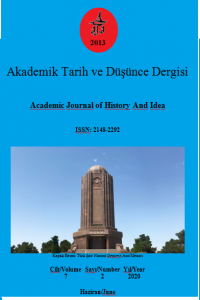19. Yüzyıl Karabağ Edebi Meclisleri “Meclisi-üns” ve “Meclisi-Feramuşan” Üyelerinin Eserlerinde İnsanın Surat Çizgilerinin Betimlenmesi
19. yüzyıl edebiyatı içerik ve
düşünce açısında yeni ve farklı olarak değerlendirilse de klasik şiir
geleneğini başarıyla sürdürmüştür. Klasik edebiyatla ilgili mecazlar sistemini
yansıtan bazı ibarelerin kullanımı bu olguyla açıklanabilir. Bu dönemde Azerbaycan`ın
çeşitli bölgelerinde bulunan diğer edebi meclisler gibi Karabağ`da da “Meclisi-üns” ve
“Meclisi-feramuşan” edebi muhitin şekillenmesinde önemli rol üstlenmiştir.Edebiyatın
temel hedefi olan insan edebiyata psikolojik durumu, iç dünyası, duygu ve
heyecanlarıyla yansır. İnsanın iç dünyasının anlaşılması, fikir ve
düşüncelerinin, psikolojik durumunun iletilmesinde yüz çizgilerinin
betimlenmesi en güvenilir araçlardan biri olarak görülebilir.19. yüzyıl
Karabağ meclisleri üyelerinin eserlerinde yüz çizgilerinin yansıması ile ilgili
temel kuralların belirlenmesi, bu aracın kullanıldığı noktaların
değerlendirilmesi amacıyla istatiksel araştırma yapma kararı verdik. Adı geçen
dönemde Doğu edebiyatında yüzyıllar boyunca şekillenen araçların kullanımında
yüz çizgileri ile ilgili bazı kalıp ifadeler kullanılmış olsa da kullanım
sıklığı açısından farklılıklar görülmektedir. Seçilen metinde yüz çizgileriyle
ilgili imgelerin kullanım sıklığı şu şekildedir: en sık kullanılanlar yüz (%22),
göz (%25), zülf (%27) kelimeleriyle ilgilidir. Bu oranların toplamı genel
anlamda yüzle ilgili ifadelerin %74`nü oluşturur. Yüz çizgileriyle ilgili
ifadeler yüzün fiziksel özelliklerinin anlatımı yahut kahramanın duygusal
durumunu yansıtmak amacıyla kullanılmaktadır. Çoğu kez imgeler betimleme
amacıyla, “bakış”, “gülümseme” gibi imgeler ise ekspresyonun sunumu amacıyla
kullanılır.
Anahtar Kelimeler:
Karabağ edebiyatı, “Meclisi-üns”, “Meclisi-feramuşan”
Facial Features of Human Presentation in the Works of Representatives of the XIX Century Karabakh Assemblies “Majlisi-uns” and “Majlisi-Feramushan”
Though the 19th century literature was characterized by new
ideas and content, classical poetry traditions were also successfully
continued. The functionality of some of the expressions that
reflect the system of scripts related to classical literature can be explained
by this factor. During this period, like other literary assemblies operating in
different regions of Azerbaijan, in Karabakh "Majlisi-uns" and
"Majlisi-Feramushan" had a leading position in the formation of the
literary environment as well.One of the main goals of literary literature - the
human is characterized by the psychological state, the inner world, the feeling
and the excitement. The description of expressive characteristics of human, the
perception of senses and explanation are of the particular interest.We have
decided to conduct a statistical survey to identify the main legal issues
related to the appearance of facial expressions in the creativity of the
representatives of the 19th century Karabakh Assemblies and to exploit the use
of these tools. Although some expressions in the Oriental literature in this
period have been used to describe facial expressions as well as the use of
template tools there are different points in terms of processing frequency. There
reflect the overall processing frequency of the facial elements in the selected
text: The highest rate of processing is related to the face (22%), eye (25%)
and hair (27%). The total of these indicators is 74% of all facial
expressions. Using to describe facial expressions or to describe
the physical characteristics of the face, or to reflect the emotional state of
the image. In many cases, for a description of separate elements, elements such
as "a look" and "smiling" are used to express
expressiveness.
Keywords:
Karabakh literature, Majlisi-Uns, Majlisi-Feramushan,
___
- GARAYEV, N., (2012). 19th-century Azerbaijani literary congresses. Baku: Institute of Manuscripts of ANAS, , p.158.
- MAKARENKO, A. S., (1958). “Pedagogical works” in 8 v. T.V. – M.,.S. 268, p.79. “Methodological and methodological problems of content analysis’’, (1973). Issue. 1M.; L.,.-130 p., p.32.
- SHULTZ, P. N., (1975). ‘’Features of representations and concepts about other people from writers, artists, engineers’’. - In: Theoretical and Applied Problems of Psychology of Cognition by People of Each Other. - Krasnodar, , pp. 331—332.
- KUZMIN, E. S.- SEMYONOV, V. E., (1979). “Social Psychology”– L.,.C.288, p.112.
- KALUGINA, E. N., ( 2008). The concepts of "man" and "woman" in the sub-standard of Russian and English languages. Stavropol,. 159 p.
- Yayın Aralığı: Yılda 6 Sayı
- Başlangıç: 2013
- Yayıncı: Hakan YILMAZ
Sayıdaki Diğer Makaleler
Arzu TAŞCAN, İlker Mümin ÇAĞLAR
Türkistan Genel Valisi Aleksey Nikolayeviç Kuropatkin’in Türkistan İzlenimleri (1916)
Muhammet ŞEN, Ferdi ÇİFTÇİOĞLU
Terminografide Sözlük Sorunları
Saib-i Tebrizî ve XVII. Yüzyıl Azerbaycan Lirik Şiirinde Hind Üslubu
Türkiye Cumhuriyeti’nde Tütün Tekeli ve Sigara Fabrikalarının Tarihsel Gelişimi (1923-1950)
Ahmed Ağaoğlu’nun Vefatının Türk Basınına Yansımaları
Meşrutiyet Döneminde Hukuksal ve Toplumsal Alanda Kadın Algısı “Nisa Hapishaneleri Örneği”
